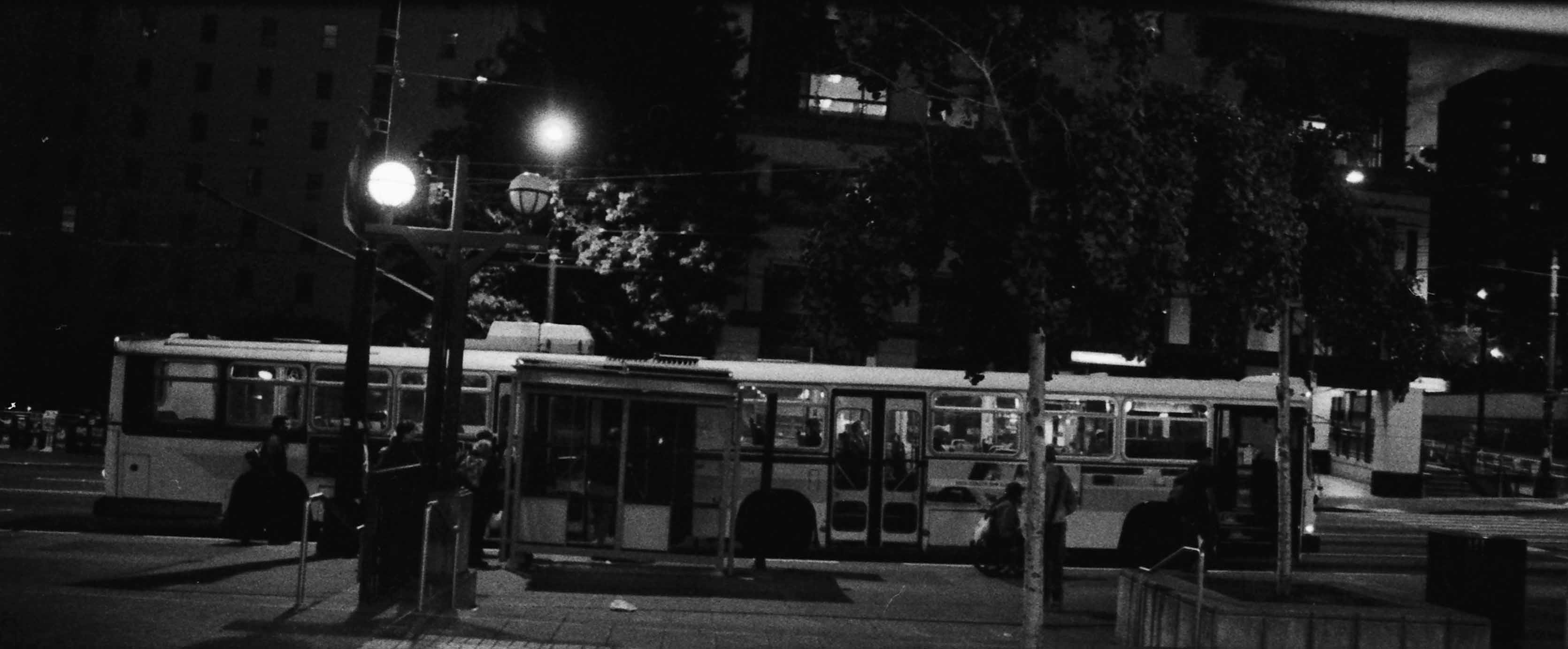His name is the same name he gives me every time: Nefarious Peripheral, No Tunnel Vision. When he first saw me, years ago, he made fun of me for my age and what he called my “Harry Potter glasses.” I think he thought I was younger than him. By the end of the ride, he’d experienced a change of heart and christened me “da coolest.” One day I’ll tell you how I talked him out of thrashing another passenger to a pulp, but then as a result had to listen to him talk about aliens for forty-five minutes, to stay on his good side.
Normally a Rainier Avenue denizen, tonight he boarded in the U District, under the influence of alcohol and who knows what else, settling in for my last trip into town. He hardly cared that I wasn’t going to the Valley on this trip. “I’m just so tired,” he breathed, in his gangster affectation, but with a tone I found touchingly wistful. A character at the end of a long play.
At the end of the line now, in Chinatown, I went to the back to wake his sleeping form. Speak in a normal voice, and clap loudly– two hard ones, hands firm and slightly cupped, close to their ears. No need for raised voices– sounds too confrontational for a disoriented, just-now-waking mind. How would you feel, after all? Ask if they can hear you okay. Just the loud claps, maybe bang on the chair if necessary (we’re not allowed to touch them), and then back quickly away if they indeed do open their eyes; that way you’re not crowding over them. People are often violent upon being woken, and you want to give them space to regroup. Mr. Peripheral, as it were, rubbed his eyes groggily and crawled through his drunken stupor back to wakefulness.
“I’m sorry, bro,” he mumbled, gathering saliva with his lips. “I been goin’ through some shit lately. Where we at? Is there a number 7 out there?”
“Yeah yeah, I think it’s there behind the elevators, on the other side. I can’t see for sure though.”
“Hol’ up, I’m gettin’ out. Wait, where we at?”
He stumbled about as stanchions and chairs bumped into him. Late twenties, twenty-seven if I recall from a previous conversation, educated but highly unstable, quick to anger but also quick to be pleased, usually high and wearing a terrific smile along with his shoulder-length dreads, clean dreads, knit cap and multiple jackets. His sagging jeans artfully covered– well, his knees, while his boxers did the real heavy lifting in terms of maintaining decorum. He absent-mindedly bumped into another stanchion as he reached one hand into his underwear, addressing incommodious scrotal arrangements. He nearly fell as he stepped from the lip of the back doorway to the pavement outside. “Did you see that,” he slurred, pointing at the ground, one shoulder knocking into the exterior of a bus window.
“Alright, have a good one,” I called after him as he slunk away.
“Thanks, bro.”
“Anytime!” I called his name out, just for fun. I like saying it. “Nefarious Peripheral!”
“No Tunnel Vision!” he called out, practically by reflex.
Then he turned, slowly. Somewhere, deep in his haze of drink and drugs and fatigue and troubles, in between drunken stupors and the rearranging of his balls, trying not to bump into things, behind his half-closed lids and faltering step, somewhere back there even still, there was a small part of his brain, some tiny little subsection, that was dedicated to knowing me. He leaned back on one leg, and it came to him. “Hey,” he said, that rich smile of his spreading out, slow motion. “You’re the photographer!”
He pronounced it with emphasis on the first syllable. PHOT-o-grapher.
“Yeah!”
“Da coolest!”
“Thanks, man! Have a good one!”
“You too!”
We both grinned mightily to ourselves as we walked our separate ways.
Nathan Vass is an artist, filmmaker, photographer, and author by day, and a Metro bus driver by night, where his community-building work has been showcased on TED, NPR, The Seattle Times, KING 5 and landed him a spot on Seattle Magazine’s 2018 list of the 35 Most Influential People in Seattle. He has shown in over forty photography shows is also the director of nine films, six of which have shown at festivals, and one of which premiered at Henry Art Gallery. His book, The Lines That Make Us, is a Seattle bestseller and 2019 WA State Book Awards finalist.



